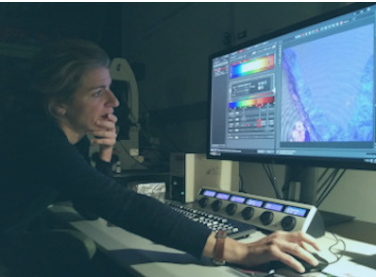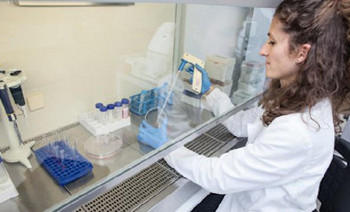The European Life Science Research Infrastructures (LS-RIs) were established to overcome a technology-gap and to allow access to much needed technologies in modern research approaches. They support cutting-edge science by offering access to the latest technologies, comprehensive resource collections and technical expertise.
Moreover, the LS-RIs collaborate closely with each other, aiming at harmonising user access, unifying data management, creating common ethical and legal services, and offering joint innovation support in order to foster interdisciplinary life science research in Europe.
The below success stories illustrate how joint support by the LS-RIs was able to help scientists with their interdisciplinary research via the CORBEL project, and how LS-RI collaboration impacts the European life science research landscape.
Morphology and structure of chondrocytes and their association with mineralizing tissues in shark and ray cartilage
Mason Dean, Max Planck Institute of Colloids & Interfaces, Potsdam, Germany, Ph.D. student Júlia Chaumel
Euro-BioImaging, EMBRC-ERIC

Cartilage performs vital functions in the skeletons of vertebrate animals, forming the embryonic scaffold for patterning adult bone, contour fillers in noses and ears, and bearing surfaces in joints. Critical to cartilage function are its embedded cells (chondrocytes), which secrete and maintain their surrounding matrix as a process of growth and response to the mechanical environment.
Understanding the roles played by these cells is vital to unraveling how skeletons grow, repair and manage loads. The skeletons of sharks and rays are composed largely of a cartilage similar to ours, but unlike our skeletons, those of sharks/rays continue to grow and mineralize throughout life. As a result, Mason Dean, a group leader at the Max Planck Institute of Colloids & Interfaces in Potsdam, Germany, and Ph.D. student Júlia Chaumel use these animals as unique systems for studying cartilage biology.
Read more
The primary goal of their CORBEL-funded project is to develop protocols for sample preparation and high-resolution imaging for cells and mineralizing tissue in shark and ray cartilage. In a 6-month longitudinal study, active mineralization zones in living animals were marked with fluorescent calcium dyes to observe skeletal growth, while novel approaches to animal collection, tissue clearing and labeling methods were also developed.
Furthermore, to visualize resultant tissue growth, extensive testing and adaptation of imaging technology was performed, with focus on both linear (e.g. fluorescence) and non-linear microscopy techniques (e.g. second harmonic generation). The project benefitted from the expert support provided by Mason’s service providers in his CORBEL project, the Institute of Photonic Sciences in Barcelona (Euro-BioImaging) and the Observatoire Océanologique de Banyuls sur Mer (EMBRC).
Screening for active compounds against acute myeloid leukemia
Maria Paola Martelli, University of Perugia, Italy
EU-OPENSCREEN, Leibniz-Forschungsinstitut für Molekulare Pharmakologie (FMP), Berlin, Germany, Euro-BioImaging EMBL-Node

Prof. Maria Paola Martelli focuses her research on acute myeloid leukemia (AML) with the aim to translate her findings into novel diagnostic tools and therapies. AML affects the maturation of myeloid blood cells leading to accumulation of abnormal cells and ultimately to bone marrow failure. AML accounts for about 80% of acute leukemia in adults with a grim prognosis in particular for elderly patients, often leaving allogeneic stem cell therapy as the only treatment option.
CORBEL is allowing us access to technologies not available in our lab and to scale-up screening of large compound libraries. This is a big step forward for our project. – – Maria Paola Martelli
Read more
Prof. Martelli is primarily interested in a genetic alteration, present in about one-third of AML cases. This was discovered by Brunangelo Falini when Martelli was a researcher in his lab and has remained a central research interest throughout her career. This mutation alters the properties of a phosphoprotein, which in its mutant form accumulates in the cytoplasm. Prof. Martelli’s CORBEL project aims to identify small molecule compounds, which attack either the mutated phosphoprotein or a key partner. To this end, the first set of experiments was carried out by Prof. Martelli’s PhD student Roberta Ranieri at the EU-OPENSCREEN Node. Access to EU-OPENSCREEN allowed her to screen their collection of compounds against AML cell lines, which she characterized in her lab together with Dr. Ilaria Gionfriddo (Assistant Professor in Hematology, at Perugia University in Prof. Martelli’s lab). Specifically, two FDA-approved drugs resulting from the screen were proved to be highly effective in our cell models and profitably synergistic with drugs already in use in the AML settings. Those promising combinations will soon be tested in murine preclinical models, prior to being employed in a clinical trial. Selected molecules are now being evaluated using advanced imaging technologies at the Euro-BioImaging EMBL-Node. This project will hopefully be a step towards novel therapy options for AML, which are desperately needed and will have a positive impact on human health.
Live call imaging to profile microglia in health and disease
Valérie Petegnief, PhD, from the Institute for Biomedical Research of Barcelona
Valérie Petegnief, PhD, from the Institute for Biomedical Research of Barcelona talks about her experience as a user of the CORBEL Open Call. Why did she apply to this call and what are her experiences accessing two different research infrastructures?
LS-RIs Respond to COVID-19
Life Sciences Research Infrastructures (LS-RIs) supported the global effort to tackle the coronavirus pandemic by prioritising COVID-19 research, as detailed in the actions below. The benefits of using established Research Infrastructures were clear: they were ready and able to provide expert advice and resources to meet a variety of research needs. Although in-person visits to facilities were restricted, many infrastructure services remained available via remote access and, where possible, the cost of access was minimised or waived.
This video presents how nine of the European Life Science Research Infrastructures can be used to advance research on coronavirus and other diseases.